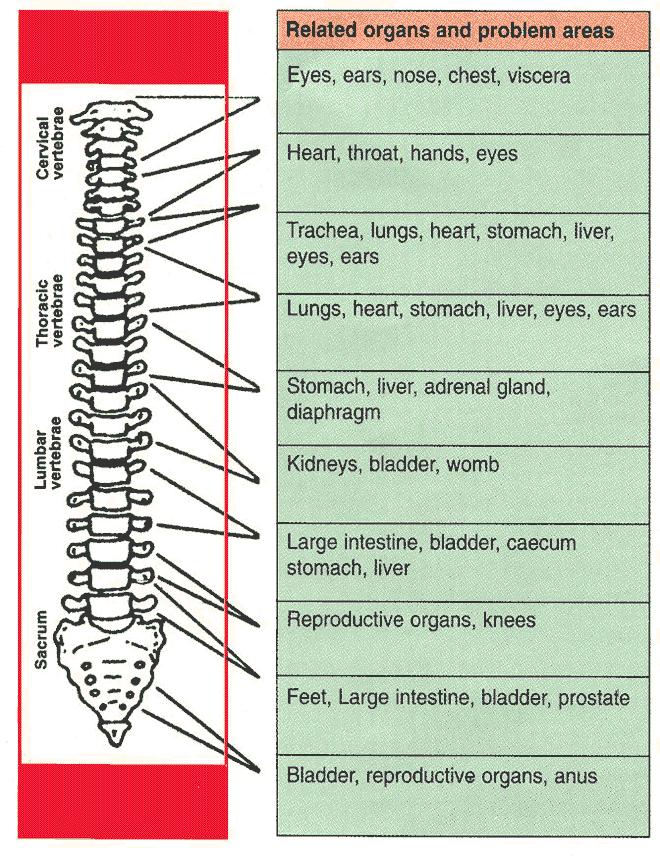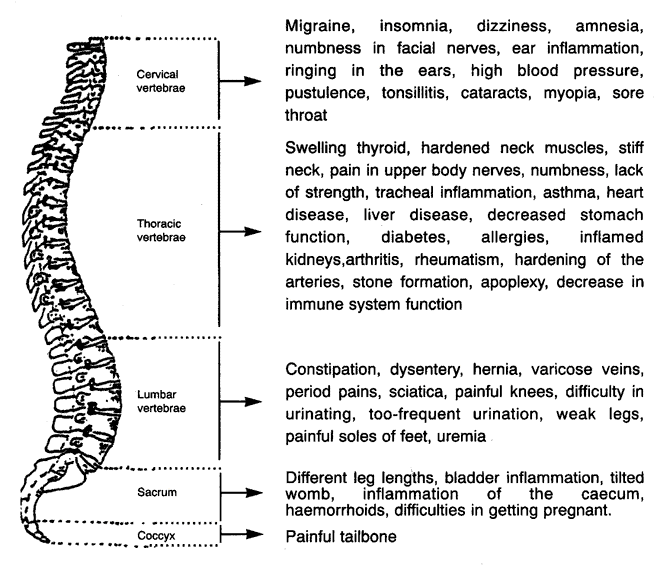Information and products on Natural Alternatives to Pain management, Medication and Surgery
The correlation between minor curvatures of the spine and diseases of the internal organs.
The Winsor Autopsies: How an M.D. discovered Chiropractic.
80% of chronic disease problems are linked to the spine.
" Why don't M.D.s believe in Chiropractic?" is a question patients commonly ask their neighborhood Chiropractors. Indeed, after years of the medical runaround---drugs, more drugs, perhaps surgery and more surgery patients have often reported 'miraculous' cures in Chiropractors offices. They then may angrily want to know why their M.D.s never suggested they go to a Chiropractor in the first place.
In all honesty many M.D.s won't stop their patients from going to a Chiropractor, they may even be relieved that their problem case is going elsewhere. But most M.D.s won't suggest a Chiropractor either. If their patients are lucky enough to discover Chiropractic, well and good, if their patients are never told about Chiropractic, well its just too bad. Part of the problem is that the medical profession has been dragging its heels in investigating Chiropractic.
But Henry Winsor, a medical doctor in Haverford, Pennsylvania felt that Chiropractic should be investigated "I wonder how Chiropractors can claim such good results" he wondered. "They claim that by 'adjusting' the fifth dorsal vertebrae, between the shoulder blades, they can relieve stomach troubles and ulcers, by 'adjusting' a lumbar vertebrae they can relieve menstrual cramps, by 'adjusting' the fifth cervical vertebrae they can correct thyroid conditions and so on with kidney disease, constipation, heart disease, lung disease, and many other conditions, but how can they do that? We M.D.s criticize them, but what if they really have discovered a new drugless way to treat disease?"
After graduating medical school Dr. Winsor investigated Chiropractic and Osteopathic literature and was inspired to perform an experiment. He would dissect human and animal cadavers to see if there was a relationship between any diseased internal organs discovered on autopsy and the vertebrae associated with the nerves that went to the organs.
As Dr. Winsor wrote: "The object of these necropsies (dissections) was to determine whether any connection existed between minor curvatures of the spine on the one hand and diseased organs on the other, or whether the two were entirely independent of each other. If the Chiropractors were right in their theory then a misaligned vertebrae that impinged a nerve going to the kidneys could weaken the kidneys and that could cause kidney diseases. If the theory was wrong then a misalignment in the 'kidney place' of the spine would not lend any corresponding problem with the kidney organs. The University of Pennsylvania gave Dr. Winsor permission to carry out his experiments, In a series of three studies he dissected a total of seventy-five human and twenty-five cat cadavers. What did the necropsies reveal? Was there a relationship between diseased organs and the spinal column?
n The following are Dr. Winsor's results: "... 221 structures other than the spine were found diseased. Of these 212 were observed to belong to the same sympathetic nerve segments as the vertebrae in curvature. Nine diseased organs belonged to different sympathetic nerve segments from the vertebrae out of line, These figures cannot be expected to exactly coincide....for an organ may receive sympathetic nerve filaments from several spinal segments and several organs may be supplied with sympathetic nerve filaments from the same spinal segment.
" In other words there was nearly a 100% correlation between 'minor curvatures' of the spine and diseases of the internal organs."
Let us examine some of these disease categories:
STOMACH DISEASES nine cases of stomach disease all had spinal misalignments in the mid-dorsal or thoracic spine (between the shoulder blades)
LUNG DISEASE Twenty-six cases of lung disease had spinal misalignments in the upper dorsal region, an area slightly below the neck.
LIVER DISEASE Thirteen cases of liver disease were associated with misalignments in the lower mid-dorsal region
GALLSTONES Five cases of gallstone disease associated with related spinal misalignments
PANCREAS Three cases of pancreas disease associated with related spinal misalignments
SPLEEN Eleven cases of spleen disease associated with spinal misalignments KIDNEY Seventeen cases of kidney disease had the lower dorsal (thoracic) 10th, 11th, 12th, vertebrae out of alignment
PROSTATE AND BLADDER DISEASE Eight cases of prostate and bladder disease had the lower back vertebrae misaligned (specifically the 1st, 2nd, and 3rd lumbar vertebrae)
UTERUS two cases of uterus conditions had the second lumbar misaligned
HEART DISEASE All twenty cases of heart and pericardium conditions had the upper five thoracic vertebrae misaligned
THYMUS Two cases of thymus disease had lower neck and upper back misalignments.
IN CONCLUSION Dr. Winsor's results were published in the respected medical journal, The Medical Times, and can be found in any medical library. But Dr. Winsor was not alone in his findings for similar studies by other researchers over the next few decades would confirm his initial conclusions A WELL ALIGNED SPINAL COLUMN IS ESSENTIAL FOR A HEALTHY BODY So although many medical doctors are ignorant of the relationship of the spinal column to disease, the medical literature is chuck full of many experiments proving Chiropractic's theory and effectiveness. An unhealthy spine can cause disease in many parts of the body and a Chiropractic spinal check up and adjustment can help in the care and prevention of sickness and disease.
All quotes taken from Winsor, H., Sympathetic Segmental Disturbances- 11. The Evidence of the Association in Dissected Cadaver of Visceral Disease with Vertebral Deformities of the Same Sympathetic Segments, Medical Times,49 1-7 Nov. 1921
  |
||
|
Dr. Lisbeth Baird D.C. , FIACA
|
Est.1998 All Rights Reserved, MAMM is a registered Trademark

